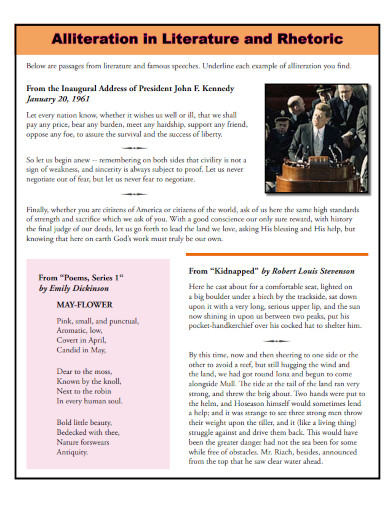Alliteration in Literature Examples
We often find a lot of figurative language and figures of speech in our literature. This is because, through the use of such literary devices, the authors are able to evoke emotions, thoughts, and ideas from the readers effectively. One of the literary devices that are frequently used in literary works is alliteration. Alliteration can be usually found in poetry, drama, and novels. Learn more about alliteration and how influenced literary works in this article.

Alliteration in Literature and Rhetoric
What is Alliteration?
Alliteration is a literary device that involves the repetition of the same initial consonant sounds in closely positioned words. It’s used to add rhythm, musicality, and emphasis, enhancing the reader’s experience. Here are some standout examples of alliteration in literature:
- “She sells seashells by the sea shore.”
This classic tongue twister is a playful use of alliteration with the “s” sound, illustrating the technique’s potential for creating memorable phrases. - “The fair breeze blew, the white foam flew.”
- The Rime of the Ancient Mariner, Samuel Taylor Coleridge
Coleridge uses the “f” and “b” sounds to mimic the natural movements of the sea, adding a lyrical quality to the narrative.
- The Rime of the Ancient Mariner, Samuel Taylor Coleridge
- “While I nodded, nearly napping, suddenly there came a tapping.”
- The Raven, Edgar Allan Poe
Poe employs the “n” sound to build suspense and evoke a somber, eerie atmosphere.
- The Raven, Edgar Allan Poe
- “Peter Piper picked a peck of pickled peppers.”
Beyond its role as a tongue twister, this example showcases alliteration’s ability to create rhythm and challenge the reader’s articulation. - “From forth the fatal loins of these two foes.”
- Romeo and Juliet, William Shakespeare
Shakespeare’s use of the “f” sound emphasizes the tragic inevitability of the story’s central conflict.
- Romeo and Juliet, William Shakespeare
- “Robbie saw rabbits resting by roses.”
An invented example that uses the “r” sound to create a peaceful, serene image, demonstrating how alliteration can set the scene or mood. - “Betty Botter bought some butter, but she said the butter’s bitter.”
This example not only plays with the “b” sound but also explores how alliteration can be used to tell a story with a playful twist. - “The big, bad bear scared all the baby bunnies by the bushes.”
Utilizing the “b” sound, this alliterative sentence paints a vivid picture that could easily belong in a children’s book, showing alliteration’s versatility.
How to write an Alliteration
To write an alliteration using the letter “s”, you could use the following phrase: “Sally sold seashells by the seashore.” In this sentence, the “s” sound is repeated in the initial position of each word, creating a musical and memorable effect. To write an alliteration, follow these simple steps:
Step 1: Choose a sound or letter that you want to repeat in your alliteration.
This could be any letter or sound that you find interesting or that you want to emphasize.
Step 2: Select words that begin with your chosen sound or letter.
You can use a thesaurus or brainstorming techniques to come up with a list of words that fit the sound or letter you have chosen.
Step 3: Arrange your chosen words into a phrase or sentence that flows smoothly and makes sense.
You can use different sentence text structures, such as a list, a question, or a statement, to create variety and interest.
Step 4: Revise and edit your alliteration to make sure it is clear, concise, and effective.
You may need to adjust the words, order, or rhythm of your alliteration to achieve the desired effect.
FAQs
What is the purpose of using alliteration in writing?
The purpose of using alliteration is to add interest, rhythm, and emphasis to writing. It can help make the language more memorable, create a sense of unity or cohesion, and draw attention to specific words or ideas.
Where is alliteration commonly used?
Alliteration is commonly used in poetry, song lyrics, slogans, and advertising. It can also be found in literature, speeches, and everyday conversation.
How do you come up with alliteration?
To come up with alliteration, choose a sound or letter that you want to emphasize and then find words that begin with that sound. You can use a thesaurus or brainstorming techniques to come up with a list of words that fit the sound or letter you have chosen.
In conclusion, alliteration is a literary technique that involves the repetition of the same initial sound in a series of words within a phrase or sentence. It is commonly used in poetry, in stanzas for song lyrics, slogans, screenplays, and advertising to add interest, rhythm, and emphasis to writing. Alliteration can be a powerful tool for making language more memorable and effective, but it should be used sparingly and deliberately to avoid overuse or contrivance. By understanding the purpose and techniques of alliteration, writers can add creativity and impact to their writing.



